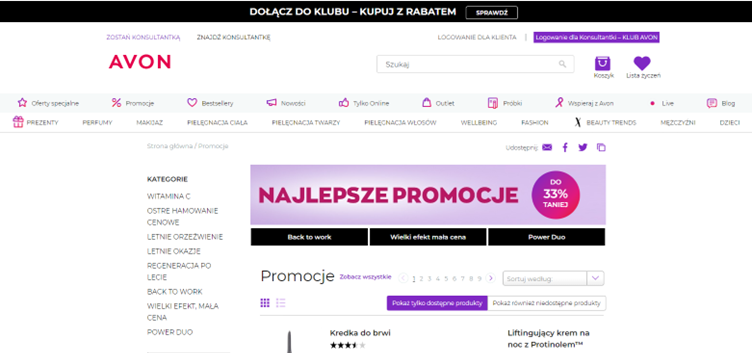


8 platforms on 50 markets - data migration to Google Analytics 4
- Bluerank & Avon
Avon is a global leader in the beauty industry with more than 6 million consultants in more than 100 countries. Due to the end of support for Google Universal Analytics, it became necessary to migrate data to a new version of the tool - Google Analytics 4 (GA4). Key to the tool's simultaneous implementatation across 8 platforms and 50 markets was a country-specific and customized configuration.
Challenge
Collaborating with Avon's global team, we are responsible for all major e-commerce platforms, from the magazine app through the mobile app to the managers' site. Each of them operates in different markets (more than 50 markets) and needs a different set of data to make decisions. Implementing an analytics tool for tens of thousands of users, including gathering requirements from key markets and training employees on a tool that was new to them, was a major challenge, and the whole process took more than a year.



Strategy and realization
Having planned activities we devided them into 7 steps
- documentation of current implementation and needs analysis,
- preparation of MVP documentation,
- discussion and implementation planning,
- technical implementation (data layer, GA4, GTM),
- testing of implementations,
- communication with markets and training,
- maintenance and technical support.
Step 1: Documentation and analysis
The first step in the migration process was to examine the current implementation of Google Analytics Universal. The implementation had been built over several years in an incremental way - a sizable number of elements were not being used, and some were outdated.
We interviewed key company representatives, including the marketing, IT and sales teams. We gathered information on the current use of Google Analytics data, business goals and the needs of the markets.
Based on the information gathered, we prepared a preliminary list of functionalities that should be transferred to GA4. We discussed this list with representatives of the global analytics team to make sure it met their needs.
Step 2: Documentation preparation
We then prepared preliminary technical documentation that detailed how to migrate to GA4. The documentation included a description of the current implementation, a list of functionality to be migrated, as well as technical specifications for the data layer, GA4 and GTM (Google Tag Manager).
Step 3: Discussion and planning
We discussed the documentation with Avon representatives, during subsequent statuses, in order to avoid possible problems after it was handed over for implementation.
Based on this discussion, we updated the documentation and presented the final implementation plan and documentation to Avon representatives and the teams that would make changes to the data layer.
Step 4: Technical implementation
The next step was technical implementation. After implementing improvements in the data layer, using dual tagging, we implemented additional tags in GTM and new GA4 accounts with subproperties (sub services, a feature from GA4 360) that aggregated data from different markets.
Step 5: Tests
After the technical implementation, we conducted testing of the implementation. Step by step, we made the tool available to key users and analysts of each platform - so that they could familiarize themselves with it and prepare the reports they use in their work. Testing enabled us to detect and fix bugs, which, with the size of the project and the number of markets/versions of site codes, were numerous.
Step 6: Communication and training
After the testing was completed, we communicated with Avon markets. This was done in multiple ways.
In addition to email communication, online meetings, we also met at so-called comunity meetings, with people involved in the various platforms, to present the concepts behind each report. It proved crucial to communicate the differences between the old version and the new one. The second element was a system of training and consultation, which we introduced and continue to introduce on an ongoing basis, for individual markets and platforms.
Convincing users to switch to the new tool and presenting the advantages of the new solution was the most difficult and complex task. There were several thousand people in more than 50 markets to train, which additionally complicated the process.
Step 7: Implementation maintenance and support
Of course, the migration process, does not end with the technical implementation and handover of the tool to the customer. Due to constant changes in the tool and the platforms we manage, it is necessary to regularly test the implementation and respond to reports from the markets. Maintaining the implementation is a key step - errors in the reports, can cause a lack of confidence in the entire GA4-based analytical process.
Results
We are confident that the regular use of data from GA4, will be an important factor for Avon in achieving business goals and effectively managing marketing campaigns.
We, on the other hand, have been reassured by this project that:
Every migration requires a detailed plan and full involvement of all parties.
With such a large scale of data, migration is a multi-stage and long-term process - in this case it took more than 12 months.
The migration doesn't stop there - due to the development of tools, it is the beginning of a process that requires the company to regularly engage and train employees.


